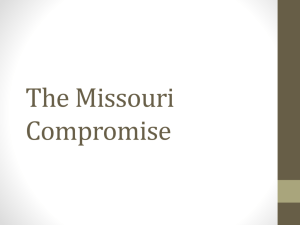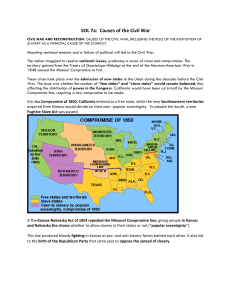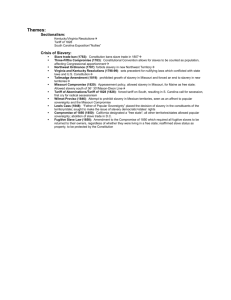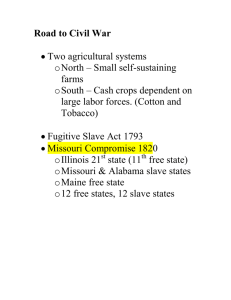Sectionalism & Civil War Unit Test Review
advertisement
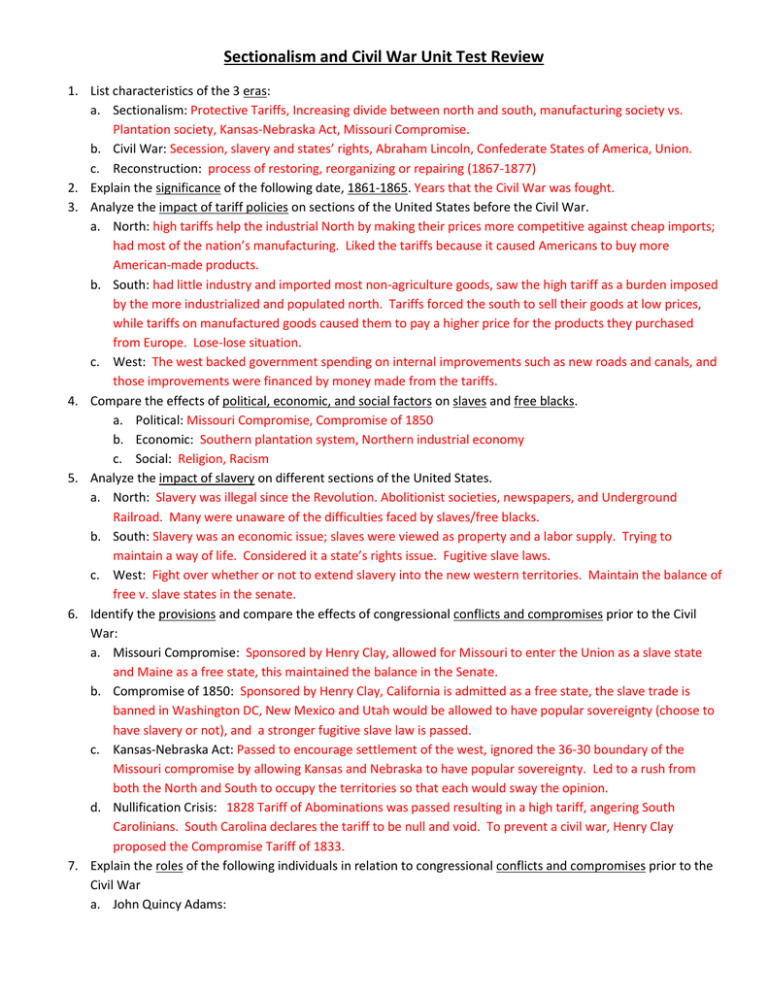
Sectionalism and Civil War Unit Test Review 1. List characteristics of the 3 eras: a. Sectionalism: Protective Tariffs, Increasing divide between north and south, manufacturing society vs. Plantation society, Kansas-Nebraska Act, Missouri Compromise. b. Civil War: Secession, slavery and states’ rights, Abraham Lincoln, Confederate States of America, Union. c. Reconstruction: process of restoring, reorganizing or repairing (1867-1877) 2. Explain the significance of the following date, 1861-1865. Years that the Civil War was fought. 3. Analyze the impact of tariff policies on sections of the United States before the Civil War. a. North: high tariffs help the industrial North by making their prices more competitive against cheap imports; had most of the nation’s manufacturing. Liked the tariffs because it caused Americans to buy more American-made products. b. South: had little industry and imported most non-agriculture goods, saw the high tariff as a burden imposed by the more industrialized and populated north. Tariffs forced the south to sell their goods at low prices, while tariffs on manufactured goods caused them to pay a higher price for the products they purchased from Europe. Lose-lose situation. c. West: The west backed government spending on internal improvements such as new roads and canals, and those improvements were financed by money made from the tariffs. 4. Compare the effects of political, economic, and social factors on slaves and free blacks. a. Political: Missouri Compromise, Compromise of 1850 b. Economic: Southern plantation system, Northern industrial economy c. Social: Religion, Racism 5. Analyze the impact of slavery on different sections of the United States. a. North: Slavery was illegal since the Revolution. Abolitionist societies, newspapers, and Underground Railroad. Many were unaware of the difficulties faced by slaves/free blacks. b. South: Slavery was an economic issue; slaves were viewed as property and a labor supply. Trying to maintain a way of life. Considered it a state’s rights issue. Fugitive slave laws. c. West: Fight over whether or not to extend slavery into the new western territories. Maintain the balance of free v. slave states in the senate. 6. Identify the provisions and compare the effects of congressional conflicts and compromises prior to the Civil War: a. Missouri Compromise: Sponsored by Henry Clay, allowed for Missouri to enter the Union as a slave state and Maine as a free state, this maintained the balance in the Senate. b. Compromise of 1850: Sponsored by Henry Clay, California is admitted as a free state, the slave trade is banned in Washington DC, New Mexico and Utah would be allowed to have popular sovereignty (choose to have slavery or not), and a stronger fugitive slave law is passed. c. Kansas-Nebraska Act: Passed to encourage settlement of the west, ignored the 36-30 boundary of the Missouri compromise by allowing Kansas and Nebraska to have popular sovereignty. Led to a rush from both the North and South to occupy the territories so that each would sway the opinion. d. Nullification Crisis: 1828 Tariff of Abominations was passed resulting in a high tariff, angering South Carolinians. South Carolina declares the tariff to be null and void. To prevent a civil war, Henry Clay proposed the Compromise Tariff of 1833. 7. Explain the roles of the following individuals in relation to congressional conflicts and compromises prior to the Civil War a. John Quincy Adams: 8. 9. 10. 11. b. John C. Calhoun: South Carolina Senator favored states’ rights and led opposition in South Carolina to the protective tariff of 1828. c. Henry Clay: Senator from Kentucky and known as the “Great Compromiser” for his ability to smooth sectional conflict through balanced legislation. Sponsored the Missouri Compromise and the Compromise of 1850. d. Daniel Webster: Senator from Massachusetts known as the “The Great Orator”, worked to create compromises with the southern states that would delay the start of the Civil War. Explain the roles played by significant individuals during the Civil War: a. Jefferson Davis: President of the Confederacy during the Civil War. b. Ulysses S. Grant: Commanding General of the Union Army. c. Robert E. Lee: Commanding General of the Confederate Army. d. Abraham Lincoln: 16th President of the United States. Explain the roles played by heroes, such as congressional Medal of Honor recipients: a. William Carney: served in the 54th Massachusetts Regiment (Union) during the Civil War, he was the first black soldier to receive the Medal of Honor. b. Phillip Bazaar: born in Chile, was a Navy seaman in the Union army, won the Medal of Honor for his distinguished service in the Civil War. Explain the causes of the Civil War, including sectionalism, states’ rights, and slavery: a. Missouri Compromise b. Compromise of 1850 c. Dred Scott vs. Sanford d. Harriet Beecher Stowe’s Uncle Tom’s Cabin e. Harper’s Ferry and John Brown f. Bleeding Kansas Explain the significant events of the Civil War: a. Firing on Fort Sumter: First shots of the Civil War, the North surrenders the fort, no deaths. b. Battle of Antietam: Battle happened in the North, the bloodies single day battle, North won. Over 23,000 casualties. c. Battle of Vicksburg: After months of a siege (surrounding the city and cutting off all resources) Grant and the Union win, gaining control of the Mississippi river and cutting the South in half. d. Battle of Gettysburg: 51,000 casualties, the second battle to take place in the North. Viewed as a turning point of the war, because after the Union victory the south was never able to invade the North again during the war. e. Announcement of the Emancipation Proclamation: Freed the slaves in the Confederacy, Lincoln was waiting for a victory to announce this and Antietam was as close as he could get. He didn’t wanted to give the soldier’s death a greater purpose and makes the Civil War a war against slavery. In doing so, he guarantees that the Confederacy wouldn’t receive any foreign support during the war. f. Appomattox Courthouse: Place of Lee’s surrender to Grant, ending the Civil War. g. Assassination of Abraham Lincoln: Shot and killed by John Wilkes Booth at Ford Theater. 12. Analyze Abraham Lincoln’s 1st and 2nd Inaugural Addresses and the Gettysburg Address, explain his ideas about the following: a. Lincolns First Inaugural Address: a. Equality: Promised to not interfere with the rights of states and the institution of slavery. b. Union: Argued that the Union could not be dissolved. c. Government: stated it was against the law to secede from the Union. 13. 14. 15. 16. d. Liberty: “I have no purpose, directly or indirectly, to interfere with the institution of slavery in the States where it exists. b. Lincoln’s Second Inaugural Address: a. Equality: Denounces slavery b. Union: Restoration and peace for the nation c. Government: Lincoln stated that there were people trying to destroy the government with or without war. d. Liberty: War will continue until slavery ceases to exist. c. Gettysburg Address: a. Equality: “… all men are created equal” b. Union: restore peace and keep the nation united c. Government: “government of the people, by the people, and for the people” d. Liberty: Principles of liberty and equality based on the Declaration of Independence. d. Contrast them with the ideas contained in Jefferson Davis’ Inaugural Address: 1) Liberty: explains liberty and equality through the lens of freedom from the North’s oppression of the South. 2) Equality: “ it is joyous in perilous times to look around upon a people united in heart, who are animated and actuated by one and the same purpose and high resolve, with whom the sacrifices to be made are not weighed in the balance against honor, right, liberty and equality.” 3) Union: breaking from the Union was a “necessity, not a choice” and that “a reunion with the states from which we have separated is neither practicable nor desirable”. 4) Government: the Confederacy had a goal of establishing a government system similar to the U.S. Constitution. Evaluate legislative reform programs of the Radical Reconstruction Congress and reconstructed state governments: a. Freedmen’s Bureau: supervised all relief and educational activities relating to refugees and freedmen, including providing them with food, clothing and education. b. 13th Amendment: abolished slavery c. 14th Amendment: guarantees citizenship and rights to all people born or naturalized in the United States. d. 15th Amendment: guarantees the right to vote to all citizens regardless of race. e. Reconstruction Act of 1867: f. Civil Rights Act of 1866: Evaluate the impact of the election of Hiram Rhodes Revels. The first African-American Senator. Explain the economic, political, and social problems during Reconstruction and evaluate their impact on different groups: a. Black Codes: Laws passed in the South during Reconstruction to limit the opportunities for blacks. b. Jim Crow Laws: laws passed to bypass laws created by the Radical Republicans and any other federal law that Southerners did not agree with concerning African-Americans. c. Ku Klux Klan: secret society that gained support in 1868 and sought to destroy the Republican Party in the South; used harsh intimidation tactics on African Americans and other groups that helped African Americans. Identify the effects of legislative acts: a. Homestead Act: granted adult heads of families 160 acres of public land for a minimal fee. Had to “improve” the land by building a dwelling and cultivating the land and after 5 years you were entitled to the property. Accelerated the settlement of the West. 17. 18. 19. 20. 21. b. Dawes Act: law allowed the President to break up Indian reservation land, which was held in common by the members of a tribe, into small allotments to be parceled out to individuals. The land usually given to the Indians was desert-like conditions unsuitable for farming. c. Morrill Act: made it possible for new western states to establish colleges for their citizens. Geared towards institutions which emphasized agriculture and mechanic arts. Describe the impact of 19th-century amendments, including 13th, 14th, and 15th amendments, on life in the United States. Explain constitutional issues arising over the issue of states’ rights, including the Nullification Crisis and the Civil War. Revolved around the ability of a state to declare federal laws unconstitutional. Issue came about over the Tariff Debate and South Carolina being strongly against the high tariff passed in 1828 and declaring it null and void. To prevent a civil war, Henry Clay proposed the Compromise Tariff of 1833. The Civil War brings the issue of state’s rights to a close, giving the federal government the dominant authority and restoring the Union. Evaluate the impact of selected landmark Supreme Court decisions, including Dred Scott vs. Sanford, on the life of the United States. Confirmed the status of slaves as property rather than citizens. Also, congress had no authority over slavery in the territories, and upon statehood, each territory would determine whether it would be a slave state or a free state. Analyze the leadership qualities of elected and appointed leaders of the United States such as Abraham Lincoln. Honesty, Courage, Inspirational, Thoughtful. Through his leadership the Union was preserved and slavery eventually abolished after his assassination in 1865. Describe the contributions of significant political, social, and military leaders of the United States such as Stonewall Jackson. Confederate General in the Civil War, earned his nickname “Stonewall” at the Battle of Bull Run, gifted tactical commander and led troops in the 1st and 2nd Battles of Bull Run (Manassas) and Antietam.

